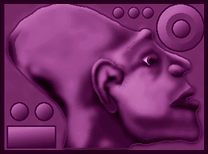
THE PERUVIAN SKULLS
A collection of photographs has been making its way through many of the internet newsgroups and causing a lively discussion. These unusually shaped skulls were photographed by Robert Connolly on his trip around the world, during which he was
collecting materials about ancient civilizations. The discovery of
the skulls was thus an unintentional and coincidental
"spinoff" of his efforts. Robert Connolly published his photographs on a CD-ROM, titled The Search For
Ancient Wisdom, Cambrix, 1-800-992-8781.
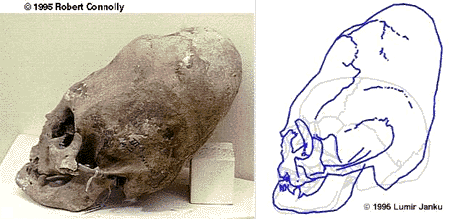
Since we only have Connolly's photographs of these skulls it would be irresponsible to suggest any date or serious race assessment. Other such skulls have been found around the globe, but this is the first time that the diversity of skulls within a small area (in this case the Paracas region of Peru) has been examined. Some of the skulls are very distinct, as if they belong to entirely different species, remotely similar to genus Homo.
The most obvious feature is the elongated cranium. This deformity has been depicted before. The rock faces of Easter Island and the images of Egyptian Pharoh, Iknathon, come to mind. In Connolley's photographs there are 4 different groups, humorously given the names: "conehead," "jack-o-lantern" or "J," the "M," and what is called, simply, the "premodern." These group types are based on the shape of the skull.
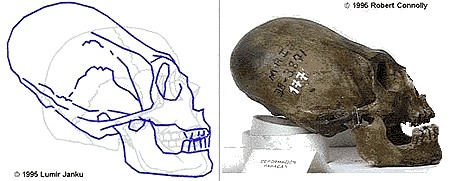
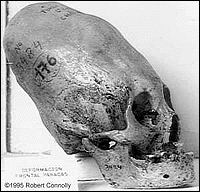 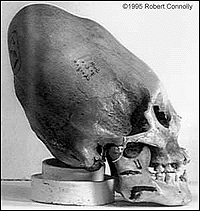 |
When some of these pictures (the first two) were posted on a newsgroup, for all eyes to scrutinize, the majority
of people assumed that they represented an example of binding of the head, well known to be in fashion
in ancient Nubia, Egypt and other cultures. Indeed the skulls show the capacity of holding about the same volume of brain matter as present day humans. But anthropoligists have admitted that the shapes of the Peruvian skulls is unlike the deformity caused by binding. The second skull raises questions for the trained anthropoligist. The frontal part of the skull seems to belong to an individual of the pre-Neanderthal family. Note the ridge over the eyebrows. But the lower jaw, though more robust than modern human type, has a modern shape and characteristics. The shape of the cranium is completely different from Homo Erectus, Neanderthal types, and the modern human type. Some minor Neanderthal characteristics are present, as with the occipital ridge on the bottom back of the skull and the flattened bottom of the cranium, but other characteristics point more towards Homo Erectus. |
The potential for this as a deformity, either an acquired or congential disease, has been ruled out by some observers because such deformities would not selectively distort the cranium with out also changing the shape of the facial bones and jaw. There is no evidence of a disease process. Further, the skulls appear to suggest that these were adults, and that this condition did not therefore inhibit life and growth. It is looking more likely that the skull belongs to a representantive of an unknown premodern human or humanoid type.
Textbooks' oldest date of appearance of humans in North America is about 35000 BCE and much later for South America, based on the diffusion theory assumptions. Only humans with modern types of anatomy can comfortably be placed Peru. These types of skulls simply should not exist.
Please view comments below.
SELECTED READER'S OPINIONS
Dear Editor,
Think about it- in India they have nose rings, in Siam there were the
anklets, the Aztecs used to embed the teeth of the wealthy with jewels and
semi-prescious stones, there were those people who wore rings around their
necks to elongate them, then couldn't take the rings off lest their heads lob
over and break their spines, the English women wore lead breastplates because
flat chests on women were a fad, ancient Native Americans used to stick
chards of bone through their pectoral muscles and dangle from strings for
days, to bring them closer to God...there are lots of strange things. Even
recent history shows women who had their lower ribs removed to better squeeze
into corsets. The Chinese used to bind women's feet by cracking the bones,
when the girl was young, folding them over, and tying them so that the bones
would grow like that, and feet would be only a size 3. Men liked the way
women's hips swayed as they staggered...which is why the high heel was
invented, a fad of today.
It wouldn't be hard to make a head shape like those skulls. All you'd have
to do is squish the baby's head between two pieces of board and bind the
board, in a sort of molding cast. The skull would grow to fit.
Please email me back and tell me what you think, ok?
Sincerely,
One has to wonder why certain tribes would consider this shape to be "special" and not a sign of deformity and disease. It suggests to me, anyway, that this is attempting to imitate some shape associated with deity or superiority and that there might have been such a race of people who once had heads like this.
As with all things in the distant past, we must come to either accept that the evidence should be taken at face value or that the ancient's had one hell of a creative imagination!
Bob from Missouri.
Hi
Concerning the pin-head sculls. Deforming of crainal shape has long been
practiced in mexico and North America.
The Flatheads of N. America used a prgressively tightened board to make the
head mor flat and therefore culturally embellished.
The Mayan's prefered a longer thinner craium and though there is not a lot of
evidence, it is clear for the outlines of their relief scupture and painted
pottery that it was consdered the in thing to have a long thin pointed
scull-- therefore early ancestors may have been the ones who started the fad,
and continued on down south to Peru. Dating and racial determinations are
more important than photos. Photos maybe of a scull that was recostructed
with animal bones and glue or other materials to look distorted when in fact
is was never that way.
Sky Ryder
After viewing theses skulls ,which could be a genetic deformity due to inbreeding within the tribe which could cause this, or could be related to the same affliction that the elephant man endured! Was there any other skeletal remains found with skulls, or any other indications of other deformities. Also, you could research area indigenous tribes myths and legends pertaining to theses remains, is there any way to do DNA testing on the skulls?
RAdams7310
I learned about skulls with abnormally elongated skulls in school a few years
back, and one of the ideas was that elongated skulls may have been a fad
among the indigenous indians of the land.
Samantha
Editor:
I agree with the comments submitted by "Samantha" that these could very well be the result of skull binding. Such things go on in the world today. I am also reminded of the Egyptian Pharoe Iknaton who was depicted with the same deformed skull shape -- but his mis-shaped skull seems to be a natural phenomenon.
